(Part 1) choosing the right steak

The Cut Matters: Finding the perfect steak
The first step to a perfect steak is choosing the right cut. My personal favourite? A good, thick ribeye. It's marbled with fat, which makes it incredibly juicy and flavourful. Think of it like a symphony of flavour – the fat melts, infusing the meat with richness and tenderness. But there are loads of other great options, too, depending on your preferences. For a leaner option, go for sirloin, with its delicate flavour and firm texture. If you're feeling adventurous, try a new york strip for a bolder flavour and a beautiful marbling pattern, or a filet mignon for a tender, melt-in-your-mouth experience.
What to Look For: Selecting the best steak
Now, when you're at the butcher's, what should you be looking for? Firstly, you want a steak that's at least an inch thick. This will allow for a nice, even cook, ensuring that the outside gets a beautiful sear while the inside cooks through without drying out. Secondly, you want to see a good amount of marbling, those streaks of fat that run through the muscle. They're what make the steak tender and flavourful, contributing that rich, buttery flavour that we all love. And last but not least, you want to make sure the steak is fresh. It should be bright red, with a smooth, dry surface free of any slime.
(Part 2) Preparing Your Steak

The Importance of Patting Dry: Setting the Stage for a Perfect Sear
Once you've got your steak, the first thing you want to do is pat it dry. Water and heat are enemies, you know. Water on the surface of your steak will steam instead of sear, which will result in a tough, grey exterior. It won't allow for that beautiful, crisp crust that we're aiming for. So take a couple of minutes to pat it dry with paper towels. You'll notice a difference in the final product.
Seasoning to Perfection: A Simple Approach to Maximum Flavour
Now, for the seasoning. This is where you can really get creative. I'm a purist when it comes to seasoning. Salt and pepper is all I need. Salt brings out the natural flavour of the steak, while pepper adds a touch of warmth and spice. But feel free to add garlic powder, onion powder, paprika, or whatever spices you enjoy. I like to season generously, coating the steak all over, even the edges. Those edges are often forgotten, but they're essential for achieving that perfect flavour.
(Part 3) Bringing Your Steak to Room Temperature

Why It Matters: The Key to Even Cooking
Here's a tip that'll elevate your steak game: bring your steak to room temperature before cooking. It might sound counterintuitive, but it's actually crucial for even cooking. A cold steak will cook unevenly, with the outside getting overcooked while the inside remains raw. The steak's core will resist heat, resulting in a tough, unevenly cooked steak. By bringing the steak to room temperature, you ensure that it cooks evenly from the inside out. This means a more tender and juicy steak, as the heat penetrates the entire steak evenly.
How to Do It: A Simple and Effective Method
Simply take the steak out of the fridge about 30-45 minutes before you plan to cook it. Place it on a plate and let it sit at room temperature. While you're waiting, preheat your oven to 400°F (200°C). This allows the oven to reach the desired temperature, ensuring that your steak cooks properly and quickly.
(Part 4) The Art of Oven-Roasting
The Oven is Your Canvas: Mastering the Technique
Alright, here's the fun part! We're going to use the oven to create that perfect sear and cook the steak to your desired doneness. Pre-heating your oven is essential. A hot oven ensures a quick and even cook, creating that beautiful, crispy crust that we're after.
A Hot Oven, A Happy Steak: The Secret to a Delicious Crust
I always preheat my oven to 400°F (200°C). It's the perfect temperature to create a beautiful, crispy crust. When the oven is ready, place your seasoned steak on a baking sheet. I like to use a rimmed baking sheet, as it catches any juices that might spill over, keeping your oven clean and your kitchen smelling heavenly.
(Part 5) Doneness: The Perfect Balance
The Power of Temperature: Understanding the internal temperature
The key to cooking a steak to perfection is understanding doneness. Doneness refers to the internal temperature of the steak. Different people prefer their steak cooked to different levels of doneness. Some like it rare, with a cool red center, while others prefer it well-done, with a brown interior.
A Doneness Chart to Guide You: Visualizing Your Desired Doneness
Here's a handy chart to guide you:
| Doneness | Internal Temperature | Description |
|---|---|---|
| Rare | 125-130°F (52-54°C) | Red center with a cool, slightly firm texture. |
| Medium-Rare | 130-135°F (54-57°C) | Pink center with a soft, tender texture. |
| Medium | 140-145°F (60-63°C) | Slightly pink center with a firm texture. |
| Medium-Well | 150-155°F (65-68°C) | Very little pink in the center with a firm texture. |
| Well-Done | 160°F (71°C) | Completely brown center with a firm, slightly dry texture. |
(Part 6) Timing is Everything: The Cooking Process
The Initial Sear: Creating that Beautiful Crust
Now, let's get cooking! Place your steak in the hot oven and cook for about 5-7 minutes per side for a medium-rare steak. You'll notice that the steak will start to brown and develop a nice crust. That's what we're aiming for. A beautiful, crispy crust seals in the juices and adds a delicious flavour and texture to the steak.
Flipping Your Steak: Ensuring Even Cooking
Flip the steak to the other side and continue cooking for another 5-7 minutes. Remember, these are just estimates. cooking times will vary depending on the thickness of your steak, the desired level of doneness, and your oven's temperature. It's always best to use a meat thermometer to check the internal temperature to ensure that your steak is cooked to your liking.
The Finish Touch: Achieving Perfection
To check for doneness, you can use a meat thermometer. Simply insert the thermometer into the thickest part of the steak. If you want a more visual approach, you can cut into the steak. If the juices are clear, the steak is well-done. If the juices are pink, the steak is rare or medium-rare. You can always adjust the cooking time as needed, keeping a close eye on the steak throughout the process.
(Part 7) Resting: Letting the Steak Relax
The Importance of Resting: Unlocking Tenderness and Juiciness
After you've taken your steak out of the oven, don't slice into it right away. It's important to let the steak rest for about 10 minutes. This gives the juices a chance to redistribute throughout the steak, resulting in a more tender and juicy cut. When you cook a steak, the heat causes the juices to move towards the center. Letting the steak rest allows those juices to redistribute evenly, ensuring that every bite is bursting with flavour.
The Resting Process: A Simple Step for Maximum Results
Simply transfer the steak to a cutting board and cover it loosely with aluminium foil. While the steak is resting, you can prepare your sides and get the table ready. This will allow the steak to relax, releasing its juices and becoming even more tender and flavorful.
(Part 8) Slicing and Serving
Slicing the Steak: The Art of Cutting
After the resting period, it's time to slice the steak. Using a sharp knife, slice the steak against the grain. This means slicing across the direction of the muscle fibres. Slicing against the grain results in a steak that's easier to chew and more tender. The muscle fibres will be cut, allowing for a softer, more enjoyable eating experience.
Serving Your Masterpiece: A Symphony of Flavours
Now, it's time to enjoy your perfectly cooked steak! Serve it with your favourite sides. I like to serve mine with mashed potatoes, asparagus, and a glass of red wine. But feel free to get creative. A steak is a versatile dish that pairs well with many sides, from classic roasted vegetables to creamy mashed potatoes and vibrant salads.
FAQs
1. What if my steak is too thin?
If your steak is too thin, you'll need to adjust the cooking time. A thin steak will cook much faster than a thick one. It's best to use a meat thermometer to check the internal temperature to ensure it's cooked to your liking. You can also try grilling it over high heat or pan-searing it in a cast-iron skillet for a quicker cook. These methods will help to achieve a crispy crust while preventing the steak from becoming overcooked.
2. What if I overcook my steak?
Don't panic! An overcooked steak might be a bit tougher, but it's not ruined. You can still enjoy it. If it's really overcooked, try slicing it thinly and adding it to a salad or stew. The tougher texture can be disguised by the other ingredients, and the flavour will still shine through.
3. Can I cook frozen steak in the oven?
It's not recommended to cook frozen steak in the oven. It will likely cook unevenly and might be tough. The outside will cook too quickly while the inside will remain frozen. It's best to thaw the steak completely in the refrigerator before cooking it. This will ensure that the steak cooks evenly and reaches the desired level of doneness.
4. What can I do with leftover steak?
Leftover steak is a great addition to salads, sandwiches, or pasta dishes. You can also slice it thinly and use it to make steak tacos or steak fajitas. The flavour of the steak will still be delicious, even after being cooked.
5. What's the best way to store steak?
To keep your steak fresh and flavourful, store it in the refrigerator in a sealed container or wrap it tightly in plastic wrap. This will help to prevent freezer burn and maintain the quality of the steak. You can also freeze steak for up to 3 months. To freeze steak, wrap it tightly in plastic wrap and then place it in a freezer-safe bag.
And there you have it! You now have all the knowledge and confidence to cook a perfect steak in the oven. So go forth and conquer! And remember, practice makes perfect. The more you cook steak, the better you'll get at it. Enjoy!Everyone is watching

How to Cook Frozen Lobster Tails Perfectly: A Step-by-Step Guide
RecipesLobster. Just the word conjures up images of lavish meals, special occasions, and a taste of luxury. But let's...

Pigs in a Blanket Cooking Time: How Long to Bake for Perfect Results
RecipesAh, pigs in a blanket. Just the name conjures up images of those delightful little parcels of crispy pastry en...

Pork Fillet Cooking Time: How Long to Cook It Perfectly
RecipesPork fillet, or tenderloin as it's sometimes called, is a real favourite in our house. It's so versatile, and...

The Ultimate Guide to Cooking Delicious Frankfurters
RecipesLet's face it, we all love a good frankfurter. It's a classic, simple, and always satisfying. But let's be rea...

The Ultimate Guide to Tender, Juicy Pulled Pork
RecipesRight, let's talk pulled pork. It's one of those dishes that just screams "comfort food," doesn't it? I mean...
